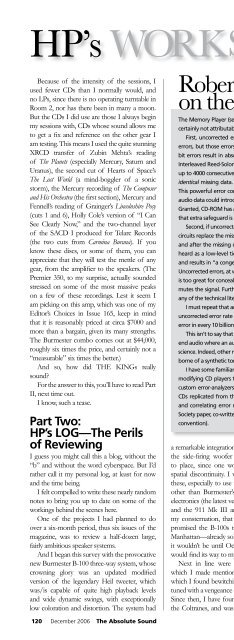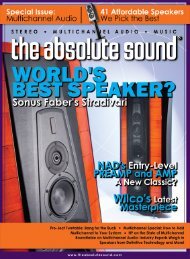Create successful ePaper yourself
Turn your PDF publications into a flip-book with our unique Google optimized e-Paper software.
HP’s Workshop<br />
Because of the intensity of the sessions, I<br />
used fewer CDs than I normally would, and<br />
no LPs, since there is no operating turntable in<br />
Room 2, nor has there been in many a moon.<br />
But the CDs I did use are those I always begin<br />
my sessions with, CDs whose sound allows me<br />
to get a fix and reference on the other gear I<br />
am testing. This means I used the quite stunning<br />
XRCD transfer of Zubin Mehta’s reading<br />
of The Planets (especially Mercury, Saturn and<br />
Uranus), the second cut of Hearts of Space’s<br />
The Lost World (a mind-boggler of a sonic<br />
storm), the Mercury recording of The Composer<br />
and His Orchestra (the first section), Mercury and<br />
Fennell’s reading of Grainger’s Lincolnshire Posy<br />
(cuts 1 and 6), Holly Cole’s version of “I Can<br />
See Clearly Now,” and the two-channel layer<br />
of the SACD I produced for Telarc Records<br />
(the two cuts from Carmina Burana). If you<br />
know these discs, or some of them, you can<br />
appreciate that they will test the mettle of any<br />
gear, from the amplifier to the speakers. (The<br />
Premier 350, to my surprise, actually sounded<br />
stressed on some of the most massive peaks<br />
on a few of these recordings. Lest it seem I<br />
am picking on this amp, which was one of my<br />
Editor’s Choices in Issue 165, keep in mind<br />
that it is reasonably priced at circa $7000 and<br />
more than a bargain, given its many strengths.<br />
The Burmester combo comes out at $44,000,<br />
roughly six times the price, and certainly not a<br />
“measurable” six times the better.)<br />
And so, how did THE KINGs really<br />
sound<br />
For the answer to this, you’ll have to read Part<br />
II, next time out.<br />
I know, such a tease.<br />
Part Two:<br />
HP’s LOG—The Perils<br />
of Reviewing<br />
I guess you might call this a blog, without the<br />
“b” and without the word cyberspace. But I’d<br />
rather call it my personal log, at least for now<br />
and the time being.<br />
I felt compelled to write these nearly random<br />
notes to bring you up to date on some of the<br />
workings behind the scenes here.<br />
One of the projects I had planned to do<br />
over a six-month period, thus six issues of the<br />
magazine, was to review a half-dozen large,<br />
fairly ambitious speaker systems.<br />
And I began this survey with the provocative<br />
new Burmester B-100 three-way system, whose<br />
crowning glory was an updated modified<br />
version of the legendary Heil tweeter, which<br />
was/is capable of quite high playback levels<br />
and wide dynamic swings, with exceptionally<br />
low coloration and distortion. The system had<br />
120 December 2006 The Absolute Sound<br />
Robert Harley comments<br />
on the Memory Player<br />
The Memory Player (see p. 120) might, indeed, produce a sonic improvement, but that improvement is<br />
certainly not attributable to the mechanism claimed by the manufacturer.<br />
First, uncorrected errors on CD playback are rare. The datastream read from a disc is rife with bit<br />
errors, but those errors are instantly corrected and replaced with the identical original data. Corrected<br />
bit errors result in absolutely no loss of information or change in sound quality. The CD’s CIRC (Cross-<br />
Interleaved Reed-Solomon Code) error-correction scheme is remarkably robust, allowing burst errors of<br />
up to 4000 consecutive bits (equivalent to 2.5mm of track length on a CD) to be reconstructed with the<br />
identical missing data. This is not interpolation or error concealment, but perfect bit-for-bit correction.<br />
This powerful error correction is what allows CD-ROM to work so well. Missing or interpolated data in<br />
audio data could introduce a momentary glitch; errors in computer code could cause a program to crash.<br />
Granted, CD-ROM has an extra layer of error detection and correction above and beyond that of CD, but<br />
that extra safeguard is rarely invoked.<br />
Second, if uncorrectable errors do occur (primarily because of disc scratches or dirt), error-concealment<br />
circuits replace the missing data with a best-guess interpolation based on the waveform’s values before<br />
and after the missing data. Error concealment is rarely audible. In some instances, concealment can be<br />
heard as a low-level tick sound. The manufacturer’s assertion that error concealment is commonplace,<br />
and results in “a congestion and harsh odd (order) harmonics borne of a synthetic tone” is simply false.<br />
Uncorrected errors, at worst, introduce momentary ticks, not a global change in sound quality. If the error<br />
is too great for concealment (12,300 consecutive bits, or 7.7mm of track length), the player momentarily<br />
mutes the signal. Furthermore, these interpolated data are not “called ECC (error correction codes)” in<br />
any of the technical literature.<br />
I must repeat that an uncorrectable error is a rare event on a CD that has not been abused. In fact, the<br />
uncorrected error rate for a reasonably well-made CD that has not been abused is roughly 10 –10 , or one<br />
error in every 10 billion bits.<br />
This isn’t to say that the Memory Player doesn’t improve the sound. There are many instances in highend<br />
audio where an audible change exists that cannot be explained by our limited understanding of the<br />
science. Indeed, other mechanisms might be at work. But “a congestion and harsh odd (order) harmonics<br />
borne of a synthetic tone” is not one of them.<br />
I have some familiarity with this subject: I worked in a CD mastering lab where my job duties included<br />
modifying CD players to extract the various error-correction flags from the decoding chips for input to<br />
custom error-analyzers, performing bit-for-bit comparisons between the data on CD mastertapes and<br />
CDs replicated from those masters, examining CD pit structures with a scanning electron microscope,<br />
and correlating error rates on replicated CDs with mastering parameters (see my Audio Engineering<br />
Society paper, co-written with Ray Keating, “CD-V Signal Optimization,” presented at the 1989 Hamburg<br />
convention).<br />
a remarkable integration of its drivers, although<br />
the side-firing woofer setup could be tricky<br />
to place, since one would run the risk of a<br />
spatial discontinuity. I wanted more time with<br />
these, especially to use them with components<br />
other than Burmester’s most impressive new<br />
electronics (the latest version of the 04 preamp<br />
and the 911 Mk III amplifier) but found, to<br />
my consternation, that Burmester had already<br />
promised the B-100s to Sound By Singer of<br />
Manhattan—already sold, I was told—and that<br />
it wouldn’t be until October that another pair<br />
would find its way to my doorstep.<br />
Next in line were the Marten Coltranes,<br />
which I made mention of in Issue 165, and<br />
which I found bewitching once they were finetuned<br />
with a vengeance (in terms of placement).<br />
Since then, I have found even more to like in<br />
the Coltranes, and was looking forward to an<br />
in-depth shot at them. Why Because, there was<br />
something about their “sweetness” that made<br />
me wonder if the ceramic drivers might not<br />
be adding a particularly glorious and musically<br />
consonant coloration to the sound. Then, there<br />
was that diamond tweeter, which struck me as<br />
some kind of breakthrough, in terms of purity<br />
and a seeming absence of an all-too-common<br />
high-frequency resonance in the audible range.<br />
The next speaker on the schedule was the<br />
top-of-the-line Usher from Taiwan a beautifully<br />
crafted and luxurious looking three-speaker<br />
system for an extravagantly reasonable price<br />
(just over $16k.) Turns out, the designer<br />
had decided to “tune” the speakers for the<br />
American market, which, in this case, meant<br />
a tweeter level that sounded audibly louder in<br />
volume than the other drivers in the cabinet,<br />
and this, to these ears, meant these were not










